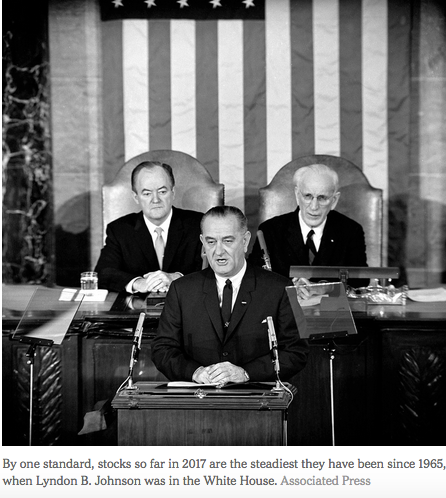Several statistical measurements demonstrate how unusual this market environment has been.
The most obvious is the bull market’s longevity, fueled largely by the Federal Reserve’s ultralow interest rates and voracious bond buying. The upward trend in stocks already ranks as the second longest in American history since 1900 and the third highest in percentage gains, according to a tally by Bespoke Investment Group. From the trend’s start, in 2009, through its latest high, on Aug. 7, the Standard & Poor’s 500 has risen 267 percent.
But that’s not all. By one standard — the market’s average daily movement, measured against its trend for that year — stocks so far in 2017 are the steadiest they have been since 1965, when Lyndon B. Johnson was in the White House and the Rev. Dr. Martin Luther King Jr. was leading an epochal civil rights march from Selma to Montgomery, Ala. On Wall Street that year, a young man named Warren Buffett gained effective control of a textile firm called Berkshire Hathaway, making it the vehicle for a legendary investing career.
. ..
Still, the stock market is linked, even if tenuously, to the real economy. And like the bull market, the economic recovery from the last recession has gone on for an extremely long time. The economic expansion in the United States is already the third longest since 1854, according to Alan Blinder, the Princeton economist, citing data from the National Bureau of Economic Research. If there is no recession until June 2019, he said, this will become the longest period without a recession.
One of these days, these various streaks will end. A big stock market decline could well precede and predict a recession. But barring a disastrous geopolitical, economic or financial shock — there are plenty of possibilities, take your pick — it is likely that both the bull market and the economic recovery will keep grinding on for a while.
But don’t count on it. We are pushing our luck. Even if you believe in magic, the markets rarely stay calm and buoyant for such an exceedingly long time.




